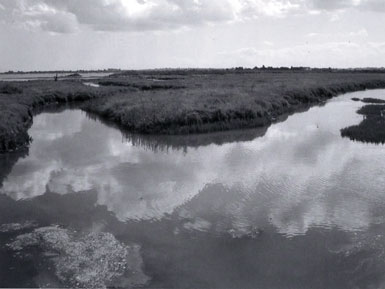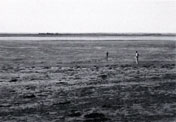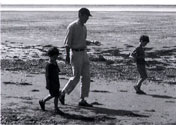
Foreward:
Chardin might have been speaking for all painters when he said of painting that, “it is an island whose shore I have skirted”.
In a series of large abstract paintings that emerge directly out of his two-year long investigation of the landscape of Osea island Luke Elwes takes Chardin’s evocative metaphor and gives it shimmering new resonances. A few hours’ drive from London, Osea’s wild, flat marshlands and empty, windswept skies have become for the artist a point of departure and a place of return. Dore Ashton wrote of Robert Motherwell, “He travels abroad and in so doing returns to his own source.”
For most of Luke Elwes’ artistic career he has travelled and painted. But he is no travel painter. His extensive journeys, and through them his exposure to the culture, beliefs, and landscape of others, have acted as a catalyst for his own line of enquiry into the nature of our relationship to the world. This exploration can be traced back to the artist’s decisive encounter with the desert at the start of the 1990s. After a decade of journeys to distant parts of the world – the Central Australian Desert, East Africa’s Great Rift Valley, New Mexico, Mount Kailash in Tibet and Cappadocia in Turkey – there is implicit in the new work a sense of homecoming.
The artist’s acute observation of the physical world, his preoccupation with the flow of time and matter as it is manifested on Osea, rewards us with canvases suffused with ambient light and the colours of water where it breaks and dissolves into earth.
The Osea paintings brim with the luminous silence of an intimacy that approaches awe and derives from a kind of looking that has been described as tenderness towards experience. It is this quality of felt intimacy that draws us so compelling into the paintings’ sphere, holds and instructs us there.
In the summer of 2002 Luke will continue his investigation of islands when he visits a wild, coniferous-forested granite island off Maine’s rugged coast. Ospreys are the guardians of this far-flung piece of wilderness. Osea and Osprey Islands will both feature in Luke’s first exhibition with Art First New York in October 2002. CS and FMD
The O in Sea:
 It appears as a container, floating between sea and sky. From a distance, it is a shifting silhouette against the intense white light. From above, a circle in space that encapsulates and magnifies the rhythm of life. It is a world of its own, the 0 in the sea, conditioned by nothing but its own perpetual motion, its tides and seasons. The island is both real and imaginary, and it constantly slips free of the memories tied to it.
It appears as a container, floating between sea and sky. From a distance, it is a shifting silhouette against the intense white light. From above, a circle in space that encapsulates and magnifies the rhythm of life. It is a world of its own, the 0 in the sea, conditioned by nothing but its own perpetual motion, its tides and seasons. The island is both real and imaginary, and it constantly slips free of the memories tied to it.
Its beguiling simplicity and rich complexity cannot be fully grasped or named. What is on the surface washes away. What lies beneath remains dark, unformed, many-layered. New things are always happening to observe, note, remember. Each time you look nothing is the same. Even as your senses awaken to its myriad wonders, it unsettles you, makes you aware of its transience. Flowers, clouds, birds, appear and disappear, as in dreams.
In its earth a history lies buried. Remnants of past human shaping and patterns are occasionally revealed. Each story and presence are like accumulated moments in the flow of the island before it returns to itself. Nothing stays still or is fixed: the path traced over its surface on one day cannot be repeated on the next. What was there before is now hidden, what was absent, now present. Mudflats rise from the water, flowers erupt on hedgerows, blossom explodes and drifts away in white clouds. Paths sink into the long grass and maze-like channels open in the receding tide, and the mosaic of glistening beach life is submerged once more.
On a wild day, the sea tears at the island’s margins, carrying earth away and returning it elsewhere as mud ready to be colonized. The elements, calm and clear on an August day, will dissolve in a cold winter mist into one another until land, water and sky give up any visible edge. On wet January mornings the saturated ground is so soft it appears to slip bodily beneath the water.
 Each of these moments is real and vital, yet of the whole nothing is certain, save that everything flows. What you think you know about the island has to be abandoned and found again in a constant process. As you hold onto a leaf, shell, feather or pebble before returning it to its microcosmos you learn to see not the names of things but the things themselves. The island subsumes your presence, like unknown others before you, into its fabric. Slowly you become more fully aware of what exists there but is unseen: the space around and between the trees, the ground below the grass, the motion in the water. Look deeply, and you feel a palpable connection that neither needs nor even has, words. An emptiness invites silence.
Each of these moments is real and vital, yet of the whole nothing is certain, save that everything flows. What you think you know about the island has to be abandoned and found again in a constant process. As you hold onto a leaf, shell, feather or pebble before returning it to its microcosmos you learn to see not the names of things but the things themselves. The island subsumes your presence, like unknown others before you, into its fabric. Slowly you become more fully aware of what exists there but is unseen: the space around and between the trees, the ground below the grass, the motion in the water. Look deeply, and you feel a palpable connection that neither needs nor even has, words. An emptiness invites silence.
The island is a retreat, not an escape but a return – to the earth, to the self. Like walking without maps or lying on the ground looking at a blue sky, the island induces a contemplation that is receptive and unconditional like the start of a painting. “In my paintings,” Mir6 wrote, “there are tiny shapes in great empty spaces. Empty spaces, empty horizons, empty plains – everything stripped down has always made a great impression on me.”
A painting finally works when its simplicity is recovered, its essence distilled from its disparate beginnings. So the island is itself a way for the artist’s mind to return to a state of clear and penetrating awareness. In exploring this terrain, the painter is drawn into Chardin’s elusive metaphor, “Painting is an island whose shore I have skirted”:
Each of these paintings is an arrival, a discovery that serves not to end but rather to perpetuate the search.
Luke Elwes
January 2002
